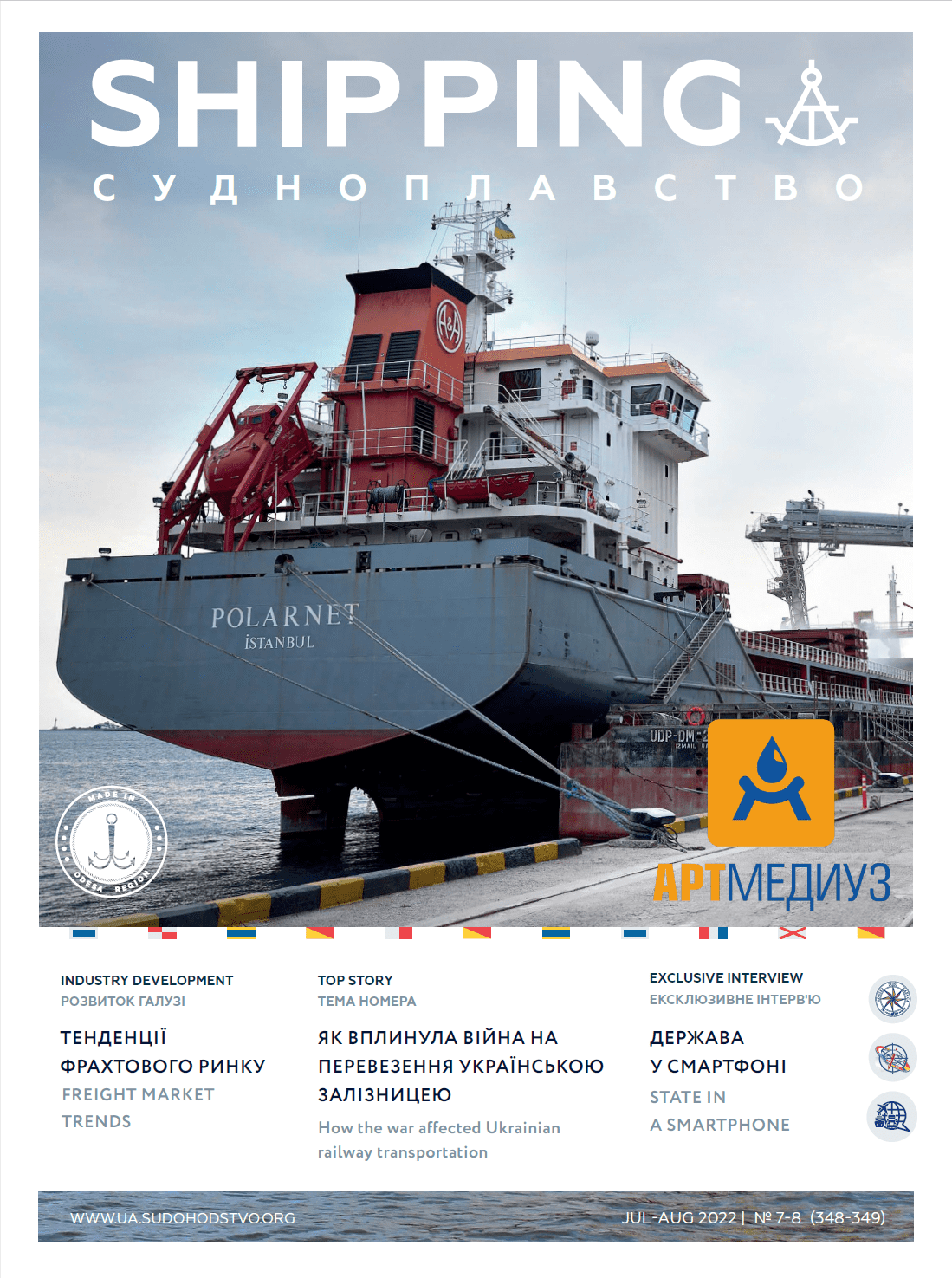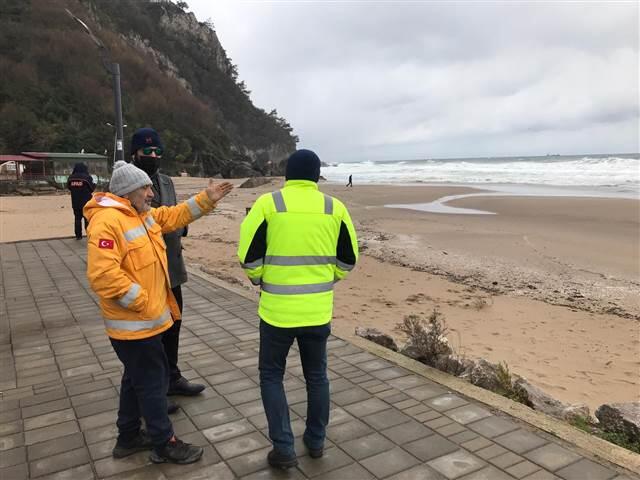
UNECE consultant

UNECE consultant
The military aggression of the Russian Federation against Ukraine led to a humanitarian catastrophe not only for Ukraine, but it also provoked a global food crisis. The blockage of Ukrainian seaports and the impossibility to export Ukrainian grain and other agricultural products to the world market led to a risk of famine in many countries and a significant increase in world food prices.
Out of the thirteen Ukrainian seaports, only three (Izmail, Reni and Ust-Dunaysk) continued to operate. In accordance with the indicators of cargo handling for 2021, these three ports handled about 3% of the total amount of cargo in the seaports of Ukraine. A critical factor before February 2022 was the significant orientation of cargo flows to maritime transport — about 75% of the total cargo turnover and about 90% for grain and vegetable oil.
The objective limitations of the transport infrastructure of the land routes accessible for cargo transportation after February 2022 did not allow for the transshipment of goods in volumes necessary to compensate for the loss of maritime traffic.
The complexity of the situation, and the impossibility to implement promptly large-scale infrastructure projects to provide for the physical expansion of the needs for logistics infrastructure became evident. Consequently, the Government of Ukraine, the EU, Ukraine’s neighboring countries, and many international organizations made efforts to reduce obstacles on these inland routes, which led, in particular, to reduction of losses due to 3.5 times increase of cargo turnover of the Ukrainian ports on the Danube River in January-September 2022 compared to the same period of 2021 – which means an increase of more than 11 million tons.
In addition, independent experts proposed projects aimed at facilitating trade and improving the efficiency of transport processes. In particular, the DUETs initiative (Ukraine-EU Digital Transport Solutions), proposed by experts of the UN Centre for Trade Facilitation and Electronic Business (UN/CEFACT) and supported by the UN Economic Commission for Europe (UNECE) and the International Port Community System Association (IPCSA), aims to apply international standards and best practices to integrate existing and proven solutions in the market and, thereby, eliminate bottlenecks and reduce the obstacles in the transport of goods between Ukraine and the EU.

Despite the positive dynamics of such initiatives, it was not possible to fully compensate for the losses of maritime transport.
The limited capacity of existing transport corridors and the impossibility of radically increasing it by traditional methods in feasible time has led to the need to find ways and approaches to improve the efficiency of the existing logistics infrastructure by trade facilitation and digital transformation of data exchange and business processes.
A significant factor for the re-establishment of exports of Ukrainian agricultural products was the Black Sea Grain Initiative (BSGI) — an agreement signed between the UN, Turkey, and Ukraine (and between the UN, Turkey and the Russian Federation) on July 27, 2022, unblocking the three largest Ukrainian sea ports (Odesa, Chornomorsk and Pivdenny) for grain exports. Already on August 1, 2022, the first ship with grain left the port of Odesa. By the end of December 2022, the BSGI allowed for additional exports of more than 14 million tons of agricultural products. This helped prevent a humanitarian catastrophe in many developing countries and stabilize world grain prices. The logistics corridor within the BSGI began to play an important role in the total volume of Ukrainian exports, and the efficiency of its functioning is critical not only for Ukraine, but for the whole world.
Based on the results of the UN Development Account COVID-19 project on digitalization of multimodal and cross-sectoral data and document exchange (https://unttc.org/stream/electronic-trade-and-transport-documents-and-data), following the recommendation of the 2022 UNECE Odessa workshop to support the digitalization of multimodal information exchange in the context of the UN Black Sea Grain Initiative (BSGI), UNECE initiated an assessment to investigate the practical application of the data pipeline concept to data exchange in this emergency corridor to improve the efficiency of this logistics route using UN (UN/CEFACT) standards and recommendations. The UN/CEFACT trade facilitation recommendations (currently over 40) are of utmost importance to government agencies and participants in supply chains, which look into the development of such data pipeline projects.
The assessment included an analysis of the existing flows of documents required for the clearance of goods handled under the BSGI. This included collecting the documents used for clearance under BSGI, extracting the data set from each document and mapping it to the UN/CEFACT Multimodal Transport Reference Data Model (MMT RDM).

The MMT RDM is currently the only functionally complete data model that combines data used by all modes of transport. As part of the hierarchy of UN/CEFACT data models, the MMT RDM provides the possibility to present information exchanged in trade and transport operations along the whole supply chain at both the administrative and business levels. The model also allows for the transformation of data from trade and transport documents into the data model format of the World Customs Organization (WCO DM), which provides a full cycle of data use in the supply chain. The model is based on a harmonized data dictionary — the UN/CEFACT Core Components Library (UN/CEFACT CCL), which allows to represent accurately links to entities from a specific domain area and transform such entities between domain areas (or jurisdictions).
The key concept of the assessment is the use of UN/CEFACT standards and artifacts, such as the MMT RDM, as a holistic set of requirements that provide the possibility to harmonize data stemming from various trade operations, transport modalities and jurisdictions. Based on this concept, the underlying data structure is directly the MMT RDM. Using a single data model for a holistic view of a logistics corridor as an element in an international supply chain allows for a practical approach to the implementation of the data pipeline concept, first introduced by David Hesketh in 2014 and further developed by UN/CEFACT within its “transport and logistics domain” . The assessment explores the possibility of practical implementation of the data pipeline concept in compliance with the UN/CEFACT recommendations and standards.
Following this concept, data is captured directly at its source and only once. It is reused throughout the supply chain, regardless of the mode of transport, the party or regulator that needs access to this data.
The basic principles of the concept of the data pipelines are as follows:
• Getting data from the right source at the right place and at the right time,
• Data acquisition once and multiple use in the supply chain,
• Passing data to the pipeline at the point of origin,
• Data to be requested from the pipeline on demand and then sent to the recipient upon assessment of their responsibility.
The main goal of data pipelines is to improve the quality of data and ensure its seamless transmission within the information flow of the supply chain by shifting the paradigm from the «documentary» exchange of information to support international trade to the concept of the «datasets». The key difference between these two concepts is that the documentary model is based on a rigid (paper or electronic) document structure, while the dataset model involves the presentation of information in the form of flexible structures — datasets (business information entities and aggregated business information entities — BIE and ABIE). The latter can be formed based on universal data models on the fly upon request for the information by the recipient in a form that meets the specific requirements of the business process.

For the practical application of the data pipeline concept in a specific logistics corridor, the degree of readiness of the IT systems of its participants is of the essence. The study analyzed the degree of adoption of UN/CEFACT standards in the documents and documentary procedures required for the clearance of goods in the framework of the BSGI. A total of 17 documents were analyzed in 6 domain areas. Further, we will take a closer look at two examples.
ROAD TRANSPORT (CONSIGNMENT NOTE)
The implementation of the electronic road consignment note system (e-TTN) inside Ukraine is carried out in partnership between the Ministry for Communities, Territories and Infrastructure Development of Ukraine and the Ministry of Digital Transformation of Ukraine with the support of the USAID / UK AID project «Transparency and Accountability in Public Administration and Services / TAPAS» and with the participation of the NGO «Institute of Analytics and Advocacy».
The goals of the project are to reduce the cost of paperwork by participants in the transport process in the amount of UAH 740 million per year and increase the speed of document processing by 90%.
The project involves building a peer-to-peer network of logistics service providers acting as access points for all participants in the transport process (B2B). The role of the State is as follows:
• formation of uniform transparent requirements for the workflow, interaction protocols and the providers,
• creation of a gateway for interaction with the government agencies,
• maintaining a unified register of consignment notes (trust anchor).
Notably, this approach is correlated with the European Regulation on electronic freight transport information (eFTI), which determines the strategic directions for the development of digital logistics in the region.
The second version of the structure of the electronic documents of the project is harmonized with the UN/CEFACT eCMR profile with the participation of UN/CEFACT experts and demonstrates consistency with the standard (according to the classification proposed under UN/CEFACT Recommendation 36 ). This approach is justified both from the point of view of ensuring multimodality within Ukraine — to enable interoperability with documents for other modes of transport, and possibility to create a national logistics platform in the future — and from the point of view of cross-border interaction, for example when introducing an electronic version of the international road consignment note (e-CMR) as well as the requirements of the EU eFTI Regulation ((EU) 2020/1056).
UNECE, in collaboration with experts from the European Commission and UN/CEFACT organized on 22 December 2022 a webinar for Ukraine to show how the experience in implementing the eFTI Regulation in parallel with supporting UN/CEFACT standards and the MMT RDM. Ms Elisabeth Türk, Director of the UNECE Economic Cooperation and Trade Division, stressed that fragmented digitalization of information flows in the international supply chains makes no sense, hence the usefulness of the global UN/CEFACT semantic standards and reference data models, which provide a common language for electronic interchange. The moderator of the webinar and UNECE Regional Adviser Mario Apostolov noted that the EU’s recent Customs Single Window and eFTI Regulations emphasize the need for mapping digitalization solutions to the global standards via the UN/CEFACT reference data models as the glue, providing the basis for interoperability in the supply chain.
Anatolii Komirnyi — Deputy Minister of Communities, Territories and Infrastructure Development of Ukraine for Affairs digital development, digital transformations and digitalization noted that the application of international standards and tools, in particular those presented by the UN/CEFACT, is a key stone of the digital transformation strategy for public services implemented in Ukraine. Harmonization of requirements for documents and data allows transforming Ukraine’s information flows into a legally significant linked chain of the electronic records, and integrate this flows into regional and global projects, such as the European eFTI Regulation, Customs and maritime single window systems, as well as ensure the sustainability of investments in such projects both by the State and by the Ukrainian business.
Thus, this example is positive in terms of readiness to adopt the concept of UN/CEFACT data pipelines as a tool to improve the efficiency of digital transport corridors.

SEAPORTS (PORT COMMUNITY INFORMATION SYSTEM)
In a transport corridor, the port is a point where jurisdiction changes — both national and mode of transport jurisdiction. In a modern port, there are more than 140 points of information interaction within the operational chain of cargo handling.
Port Community Systems (PCS) have become widespread around the world due to increased economic efficiency and improved interaction between public and business parties. The concept of such community information systems has gone far beyond seaports — similar systems are being created at airports. The concept of Cargo Community Systems has appeared, covering the handling of goods in certain directions, closely intersecting with the concept of the Transport Corridor Information System.
In Ukraine, as in many countries of the post-Soviet area, the need to orchestrate interaction of public and private partners in ports arose only in the 1990s. This, among other factors, made it necessary to learn the rich international experience in building electronic interaction systems in ports, as well as the UN/CEFACT recommendations and EU directives and regulations. As a result, in 2012, with the support of the UNECE, the Port Community Information System (ISPC) project was launched in the seaport of Odessa. Its operation was subsequently extended to all 13 seaports of Ukraine.
The main normative act regulating the work of this port community system is the Decree of the Cabinet of Ministers of Ukraine No. 451 dated 21.05.2012.
A valuable feature of the Ukrainian PCS project was the combination of the positive aspects from two concepts — port single window (PSW) and port community system (PCS), which made it possible to implement both B2B and B2G flows within the framework of a single harmonized information exchange system.
The basis for organizing data processing in the system is the UN/CEFACT Multimodal Transport Reference Data Model (MMT RDM) and the UN/CEFACT Core Components Library (UN CCL). Based on these building blocks, documents and application programming interfaces (API) are implemented to support business processes defined by international agreements and standards, as well as local requirements.
As a result, it was possible to implement the transformation of data between linked records (datasets) in accordance with the documentary flow of cargo handling in the port. As an example, a maritime bill of lading and a cargo manifest for a vessel can be generated based on data from documents available at previous stages of the business process, in particular (road or rail) waybills, acceptance notes, loading orders, etc. Consequently, the Ukrainian Port Community System ISPC (PPL 33-35) is a unique example of the practical implementation of the UN/CEFACT data pipeline concept.
An analysis of the transformation of data in datasets from real-world business documents involved in the cargo handling process in the BSGI logistics corridor allowed to identify several other significant factors influencing the possibility to apply the concept of data pipelines in practice.
Much has already been done to facilitate trade and achieve the digital transformation of processes and data along this logistics corridor. The results of the study showed that most of the documents involved in this supply chain are available in electronic form (either exclusively or in parallel with paper versions). Moreover, the degree of acceptance of international standards in the digitalization projects is significant.
We can argue that a digital logistics corridor (or, more precisely, a digital information flow in this logistics corridor) exists.
The main obstacle that needs to be highlighted from the results of the assessment is the fragmentation of efforts at digitalization, which cut this information flow. Existing electronic documents are de facto used only within the framework of individual local business transactions and are not transferred along the entire corridor from its beginning to the end. In some cases, data in derived documents is automatically converted from the source documents, as in the ISPS. In other cases, data in derived documents is not automatically converted from the source documents and re-entered manually. This cancels much of the benefit offered by the UN/CEFACT data pipeline concept.

The use of local code lists that are not harmonized with international requirements also complicates the automation of the process of converting data between trade and transport documents within the supply chain, even in the case of unambiguous identification of the data attribute class.
It is important to emphasize the key role of the State in supporting the utilization of already implemented projects and the development of new ones, which will accelerate the process of digital transformation of processes and data in a significant part of business operations.
Our analysis allowed to identify both strengths and obstacles on the way to the implementation of a seamless data pipeline in the supply chain of goods exported under the Black Sea Grain Initiative. As a result, we formulated several recommendations aimed at the practical implementation of mechanisms that promote trade facilitation and harmonization of electronic data exchange using UN/CEFACT global standards for transport, trade and logistics. The harmonization of data sets with the UN/CEFACT data models hierarchy demonstrates the feasibility of providing better quality data from trade and transport documents to regulatory agencies to deliver their decision-making and control functions. The use of data pipelines, as a step in the digital transformation process, is an effective tool for increasing the efficiency of the supply chain through the seamless transformation of data presented in the form of the linked datasets (records).
The data pipeline concept is still a desirable objective for the BSGI, Ukraine, and the region. Yet with every step in building harmonized data exchanges, using the UN/CEFACT standards, we are getting closer to it, as our study demonstrates. It cites the concrete actions that need to be taken in this direction.
The authors express the hope that this work will help mitigate the global food security crisis caused by the military aggression of the Russian Federation against Ukraine and strengthen Ukraine’s position as a trade hub using UN standards.
The full version of the assessment report will be published on the UNTTC site.






















